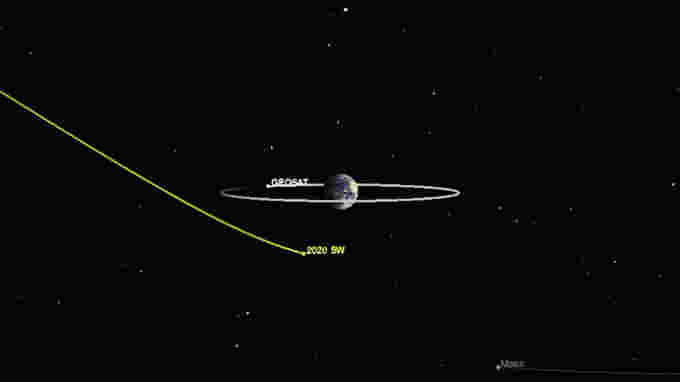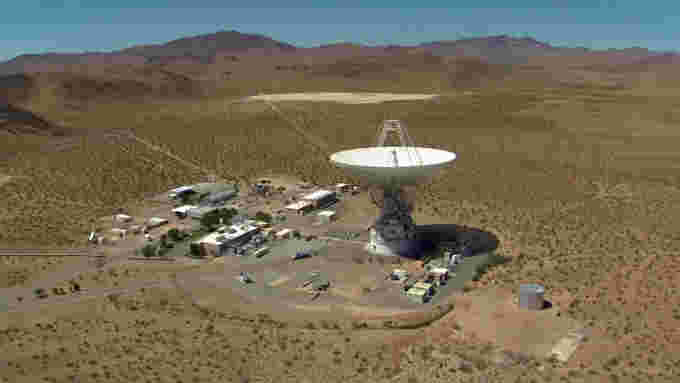Astronomers are tracking a newfound asteroid that is expected to make a brief but very close pass by Earth, early Thursday morning.
Asteroid 2020 SW was discovered on September 18, by the Catalina Sky Survey in Arizona. Estimated at between 5 to 10 metres wide, this space rock will make its closest pass by Earth at 7:12 a.m. EDT, on Thursday, September 24.
At that time, it is expected to be roughly 22,000 kilometres above the planet's surface.
"There are a large number of tiny asteroids like this one, and several of them approach our planet as close as this several times every year," Paul Chodas, director of the Center for Near-Earth Object Studies (CNEOS) at NASA's Jet Propulsion Laboratory, said in a press release on Wednesday. "In fact, asteroids of this size impact our atmosphere at an average rate of about once every year or two."
 This frame from the NASA asteroid trajectory animation shows 2020 SW at its closest approach to Earth. Credit: NASA JPL
This frame from the NASA asteroid trajectory animation shows 2020 SW at its closest approach to Earth. Credit: NASA JPL
At that distance, the asteroid is actually closer than the ring of geostationary weather and communications satellites surrounding Earth at a distance of around 36,000 kilometres. However, as the image above shows, by then, the asteroid will be below the satellite ring and beneath Earth.
Although 2020 SW is logged as a "potentially hazardous asteroid" in NASA's records, it doesn't pose any threat to Earth. According to CNEOS, who has traced the asteroid's orbit back to 1975 and forward to 2095, this September 24 pass is the closest this object has ever come to us in that timespan.
 The shape of asteroid 2020 SW's 373-day orbit around the Sun marks it as an Apollo asteroid - an Earth-crossing asteroid that spends all of its time between the orbits of Venus and Mars. Credit: NASA CNEOS
The shape of asteroid 2020 SW's 373-day orbit around the Sun marks it as an Apollo asteroid - an Earth-crossing asteroid that spends all of its time between the orbits of Venus and Mars. Credit: NASA CNEOS
The next time the asteroid will be anywhere close to Earth again is in September of 2041. At that time, it will be pass far beyond the Moon, at a distance of over 3.5 million kilometres.
RELATED: DID ASTEROID CRATERS KICKSTART LIFE ON EARTH?
While 2020 SW poses no threat to Earth, it is still of interest to scientists. NASA's Goldstone Observatory is planning to bounce radio waves off the asteroid's surface during this close pass. The data collected can then be turned into radar images, revealing the asteroid's shape and giving us an idea of its composition.
 The 34-meter DSS-13 radio antenna at the Goldstone Observatory is used for radio astronomy, including collecting radar images of passing near-Earth objects. Credit: NASA
The 34-meter DSS-13 radio antenna at the Goldstone Observatory is used for radio astronomy, including collecting radar images of passing near-Earth objects. Credit: NASA
According to NASA, if 2020 SW or an asteroid of similar size did actually strike Earth, it would almost certainly break apart high up in the atmosphere as a fireball. Only the toughest space rocks of this size - those primarily composed of metal - can reach the surface mostly intact.
"The detection capabilities of NASA's asteroid surveys are continually improving," added Chodas, "and we should now expect to find asteroids of this size a couple days before they come near our planet."
Indeed, the fact that this tiny rock was spotted roughly six days before its flyby is a testament to the Catalina Sky Survey's asteroid detection skills.
Sources: NASA JPL | NASA CNEOS
https://news.google.com/__i/rss/rd/articles/CBMic2h0dHBzOi8vd3d3LnRoZXdlYXRoZXJuZXR3b3JrLmNvbS9jYS9uZXdzL2FydGljbGUvbmV3bHktZGlzY292ZXJlZC10cnVjay1zaXplZC1hc3Rlcm9pZC1idXp6ZXMtYnktZWFydGgtb24tdGh1cnNkYXnSAXdodHRwczovL3d3dy50aGV3ZWF0aGVybmV0d29yay5jb20vY2EvYW1wL25ld3MvYXJ0aWNsZS9uZXdseS1kaXNjb3ZlcmVkLXRydWNrLXNpemVkLWFzdGVyb2lkLWJ1enplcy1ieS1lYXJ0aC1vbi10aHVyc2RheQ?oc=5
2020-09-23 21:10:00Z
52781071592585
Tidak ada komentar:
Posting Komentar